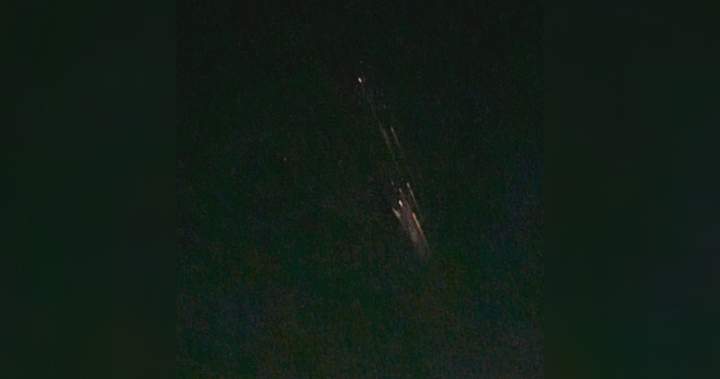More than a year after space debris likely linked to a SpaceX spacecraft landed in Saskatchewan, remnants of a Starlink satellite re-entering Earth’s atmosphere was spotted last week over the skies of the province.
Samantha Lawler, an associate professor of astronomy at the University of Regina, told Global News about the Starlink satellite re-entry and said she’s urging farmers east of Saskatoon to keep an eye out for space debris.
“It’s getting to be more common,” Lawler told Global News of space debris re-entering the atmosphere. “Here on the southern Prairies, we’re under the densest band of them just because of the orbits that have been chosen. So right here is the most likely to see the re-entries happen.
“I would love for people to get out and look and see if any pieces made it to the ground.”
The Canadian Space Agency told Global News in an email it was “aware of the event” in Saskatchewan and continues to monitor developments related to space debris in collaboration with domestic and international partners.
“Although no debris has been confirmed to have reached the ground in this case, the CSA remains attentive to public safety and acknowledges the concerns associated with the re-entry of space objects,” a spokesperson for the agency wrote.
A Starlink satellite re-entering Earth is not unusual, with SpaceX noting the technology operates in a low orbit below 600 km.
“Atmospheric drag at these altitudes will deorbit a satellite naturally in five years or less, depending on the altitude and satellite design, should one fail on orbit,” according to a SpaceX report on space sustainability.
According to astronomer Jonathan McDowell, who tracks Starlink satellites, there are currently about 8,543 in orbit with 8,527 that are working.
Get breaking National news
For news impacting Canada and around the world, sign up for breaking news alerts delivered directly to you when they happen.
It’s not the first time SpaceX technology is believed to have been found on Canadian soil or for space debris to have landed here.
Last May, the Canadian Space Agency said it was looking into space debris that had been found on a farm northwest of Regina.
Experts, including Lawler, told Global News at the time that the debris was likely linked to a SpaceX spacecraft that returned to Earth in February and was later collected by the company, as required by international law.
Prior to last May, another object crashed through the roof of a Florida home in March 2024, while a chunk of debris was found on Australia farmland in 2022.
But objects have also fallen to Earth this year as well, with a large piece found in a village in Kenya’s south in January, measuring about 2.5 metres in diameter and weighing about 500 kg. It was believed to be a fragment from a rocket.
When the space debris fell last year in Saskatchewan, the Canadian Space Agency told Global News that there have been about 36,000 space objects flying in low Earth orbit since Dec. 20, 2023.
The risk of space debris hitting someone on the ground is relatively low. All launches in the U.S., for example, fall under the Orbital Debris Mitigation Standard Practices, which require the risk of a casualty from a re-entering rocket body to be below a one-in-1,000 threshold.
But while most space debris does disintegrate and burn up when re-entering the atmosphere, there can be the rare case it doesn’t, in which case first responders and public safety will step in.
“So anything that survives the re-entry will get to the ground,” Lawler said. “Anybody watching this, don’t worry about getting hit by space junk, you’re not going to get hit by space junk. The odds are so low for any individual, but every time we have a re-entry, it’s like you’re rolling the dice again and eventually, someone’s going to get hurt.”
Under the Outer Space Treaty, which provides the basic framework on international space law, rules dictate who is responsible should such a case arise.
The treaty says that states, or countries, will be responsible for national space activities whether carried out by governmental or non-governmental entities and will be held liable for any damage caused by their space objects.
“While the likelihood of debris causing harm remains very low, the CSA supports ongoing efforts to improve tracking, prediction, and mitigation strategies. We remain committed to working with our partners to ensure that space activities are conducted safely and sustainably,” the Canadian Space Agency said.
Lawler said if farmers or residents do come across any space junk, they should call the RCMP or local authorities, then they can reach out to the Outer Space Institute, which would further investigate where the “junk” came from.”
“I would like to know if pieces are making it to the ground, like that’s really scary to think about that many satellites dropping pieces,” Lawler said.
“They say they don’t, but this is the only way to check is to get people out and looking.”
© 2025 Global News, a division of Corus Entertainment Inc.
https://globalnews.ca/news/11456027/space-junk-debris-falls-to-earth-saskatchewan/


